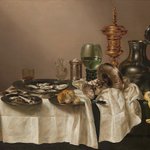
Still Life with a Gilt Cup, Willem Claesz Heda, 1635 - Rijksmuseum

When the archaeologists reached the inner chamber, they found its contents completely intact – it hadn’t been robbed,like so many of the other, more obvious burial mounds in the area. Inside, they discovered a tomb, containing a wealth of treasure and the mortal remains of a man who quickly became known as the Hochdorf Prince
At $236.4 million, a portrait by Gustav Klimt is the second most expensive painting sold at auction, while Maurizio Cattelan’s golden toilet drew $12.1 million.
nytimes.com
Still-life, after all, was the chief image of private property in Western art.